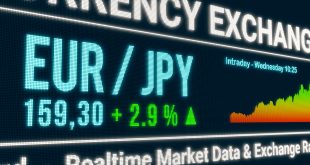As markets prepare for another US NFP jobs report that is expected at the end of the week, the US dollar depreciated on Monday, allowing other currencies to regain some much-needed ground. With a gentle decline, the US Dollar Index (DXY) dropped again below the 109.00 barrier and lost almost two-thirds of a percent. The safe-haven USD is declining overall as broad-market risk sentiment returns to its previous level.
EUR/USD bidders were focused on buying on Monday, which helped the pair regain its position near the 1.4000-handle. Tuesday’s European market session will begin with the release of preliminary European Harmonized Index of Consumer Prices (HICP) inflation data. Markets will be anticipating a modest increase in headline inflation data. However, because underlying inflation pressures seem to be continuing to decrease, traders are unlikely to get very fearful or greedy even if near-term inflation numbers increase.
At the start of the new trading week, the GBP/USD pair had a similar surge, rising seven-tenths of a percent and regaining its position above the 1.2500 handle. This week, there is still a dearth of UK economic data, and the sentiment of the Greenback market as a whole will have the biggest impact on the pair.
The AUD/USD attempted to ignite a bullish rebound, but bidding efforts failed, and after briefly touching the important technical mark, Aussie bids dropped down below the 0.6300 handle. Despite a little improvement over the weekend, the Australian Purchasing Managers Index (PMI) data was insufficient to force the AUD to break out of its recent lows.
Despite the Greenback’s decline, gold prices were unchanged at the start of the week. While US President-elect Donald Trump made news because to his unclear tariff proposals, higher US Treasury bond yields sustained pressure on the non-yielding metal. At $2,638, the XAU/USD exchange rate is essentially constant.
When the US dollar suddenly became weaker, the yellow metal was unable to profit. US Treasury yields rose as a result of speculation that the Trump administration’s impending agenda may rekindle inflation and concerns that a Republican-controlled Congress might result in a larger government budget deficit.
Also Read:
Corporate Bankruptcies In Germany Touch 2008’s Levels, Record High In Switzerland
Canadian Dollar rebounds despite PM Trudeau resignation
Dow Jones Surges as Tech Soars, Tariff Concerns Ease
Euro Gains Following German CPI
Markets React as Trump Denies Critical Import Tariffs Amid Ongoing Discussions
XAU/USD Dips as Yields Rise, Market Awaits Key Economic Data

 Noor Trends News, Technical Analysis, Educational Tools and Recommendations
Noor Trends News, Technical Analysis, Educational Tools and Recommendations




